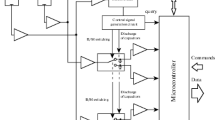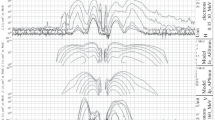Abstract
The results of experiments onboard the Lomonosov satellite on observing natural and technogenic space hazards including electromagnetic transients and space debris are discussed. A new space project Universat-SOCRAT being developed by Moscow State University is also discussed. The project aims to create a constellation of small satellites for real-time monitoring of the radiation environment and potentially hazardous objects of natural (asteroids, meteoroids) and technogenic origin (space debris) in near-Earth space, and such phenomena as cosmic and atmospheric gamma-ray bursts and optical and ultraviolet radiation flashes from Earth’s atmosphere.



Similar content being viewed by others
Notes
Abbreviation “Universat”—University Satellite; “SOCRAT”—System of Observing the Cosmic Radiation, Asteroid and Technogenic hazard.
REFERENCES
Sadovnichy, V.A., Panasyuk, M.I., Amelushkin, A.M., et al., Lomonosov satellite—space observatory to study extreme phenomena in space, Space Sci. Rev., 2017, vol. 212, nos. 3–4, pp. 1705–1738.
Sadovnichii, V.A., Amelyushkin, A.M., Angelopoulos, V., et al., Space experiments aboard the Lomonosov MSU satellite, Cosmic Res., 2013, vol. 51, no. 6, pp. 427–433.
Panasyuk, M.I., Svertilov, S.I., Bogomolov, V.V., et al., Experiment on the Vernov satellite: Transient energetic processes in the Earth’s atmosphere and magnetosphere. Part I: Description of the experiment 2016, Cosmic Res., 2016, vol. 54, no. 4, pp. 261–269.
Panasyuk, M.I., Svertilov, S.I., Bogomolov, V.V., et al., Experiment on the Vernov satellite: Transient energetic processes in the Earth’s atmosphere and magnetosphere. Part II: Final results, Cosmic Res., 2016, vol. 54, no. 5, pp. 343–350.
Sadovnichii, V.A., Panasyuk, M.I., Yashin, I.V., et al., Investigations of the space environment aboard the Universitetsky–Tat’yana and Universitetsky–Tat’yana-2 microsatellites, Sol. Syst. Res., 2011, vol. 45, no. 1, pp. 3–29.
Mullen, E.G., Gussenhoven, M.S., Ray, K., and Violet, M.A., A double-peaked inner radiation belt: Cause and effect as seen on CRRES, IEEE Trans. Nucl. Sci., 1991, vol. 38, pp. 1713–1718.
Myagkova, I.N., Bogomolov, A.V., and Shugai, Yu.S., The dynamics of relativistic electron fluxes in the near-Earth space in 2001–2005, Moscow Univ. Phys. Bull., 2010, vol. 65, no. 3, pp. 234–237.
Tverskaya, L.V., Balashov, S.V., Veden’kin, N.N., et al., Outer radiation belt of relativistic electrons during the minimum of the 23rd solar cycle, Geomagn. Aeron. (Engl. Transl.), 2012, vol. 52, no. 6, pp. 740–745.
Harris, A., The population of near-Earth asteroids, Icarus, 2015, vol. 257, pp. 302–312.
Mainzer, A., Bauer, J., Grav, T., and Masiero, J., The population of tiny near-Earth objects observed by NEOWISE, Astrophys. J., 2014, vol. 784, no. 2, id 110.
Gurevich, A.V., Milikh, G.M., and Roussel-Dupre, R.A., Runaway electron mechanism of air breakdown and preconditioning during a thunderstorm, Phys. Lett. A, 1992, vol. 165, nos. 5–6, pp. 463–468.
Mareev, E.A., Evtushenko, A.A., and Yashunin, S.A., On the modelling of sprites and sprite-producing clouds in the global electric circuit, in Sprites, Elves and Intense Lightning Discharges, Füllekrug, M., et al., Eds., Springer, Netherlands, 2006, pp. 313–340.
Milikh, G.M., Valdivia, J.A., and Papadopoulos, K., Spectrum of red sprites, J. Atmos. Terr. Phys., 1998, vol. 60, nos. 7–9, pp. 907–915.
Surkov, V.V. and Hayakawa, M., Underlying mechanisms of transient luminous events: A review, Ann. Geophys., 2012, vol. 30, no. 8, pp. 1185–1212.
Fishman, G.J., Bhat, P.N., Mallozzi, R., et al., Discovery of intense gamma-ray flashes of atmospheric origin, Science, 1994, vol. 264, no. 5163, pp. 1313–1316.
Dwyer, J.R., Smith, D.M., and Cummer, S.A., High-energy atmospheric physics: Terrestrial gamma-ray flashes and related phenomena, Space Sci. Rev., 2012, vol. 173, nos. 1–4, pp. 133–196.
Dwyer, J.R., The relativistic feedback discharge model of terrestrial gamma ray flashes, J. Geophys. Res., 2012, vol. 117, no. A2, A02308.
Garipov, G., Grigoriev, A., Khrenov, B., Klimov, P., and Panasyuk, M., High energy transient luminous atmospheric phenomena: The potential danger for suborbital flights, in Extreme Events in Geospace, Buzulukova, N., Ed., Elsevier, 2017, pp. 473–490.
Bhat, P.N., Meegan, C.A., von Kienlin, A., et al., The 3rd Fermi GBM gamma-ray burst catalog: The first six years, Astrophys. J. Suppl. Ser., 2016, vol. 223, no. 2, id 28.
Radioactive space debris: what goes up, must come down, WISE/NIRS Nuclear Monitor, no. 629, June 10, 2005.
Anikeeva, M.A., Boyarchuk, K.A., and Ulin, S.E., Space debris detection onboard a space vehicle, Vopr. Elektromekh., 2012, vol. 126, no. 1, pp. 13–18.
Klimov, P.A., Panasyuk, M.I., Khrenov, B.A., et al., The TUS detector of extreme energy cosmic rays on board the Lomonosov satellite, Space Sci. Rev., 2017, vol. 212, nos. 3–4, pp. 1687–1703.
Svertilov, S.I., Panasyuk, M.I., Bogomolov, V.V., et al., Wide-field gamma-spectrometer BDRG: GRB monitor on-board the Lomonosov mission, Space Sci. Rev., 2018, vol. 214, no. 1, id 8.
Lipunov, V.M., Gorbovskoy, E.S., Kornilov, V.G., et al., SHOK—the first Russian wide-field optical camera in space, Space Sci. Rev., 2018, vol. 214, no. 1, id 6.
Park, I.H., Panasyuk, M.I., Reglero, V., et al., UFFO/Lomonosov: The payload for the observation of early photons from gamma ray bursts, Space Sci. Rev., 2018, vol. 214, no. 1, id 14.
Adams, J.H. and the JEM-EUSO collaboration, Space experiment TUS onboard the Lomonosov satellite as pathfinder of JEM-EUSO, Exp. Astron., 2015, vol. 40, no. 1, pp. 315–326.
Khrenov, B.A., Klimov, P.A, Panasyuk, M.I., et al., First results from the TUS orbital detector in the extensive air shower mode, J. Cosmol. Astropart. Phys., 2017, vol. 2017, no. 9, id 006.
Khrenov, B.A. and Stulov, V.P., Detection of meteors and sub-relativistic dust grains by the fluorescence detectors of ultra high energy cosmic rays, Adv. Space Res., 2006, vol. 37, no. 10, pp. 1868–1875.
Adams, J.H., Ahmad, S., Albert, J.N., et al., JEM-EUSO: Meteor and nuclearite observations, Exp. Astron., 2015, vol. 40, no. 1, pp. 253–279.
Abdellaoui, G., Abe, S., Acheli, A., et al., Meteor studies in the framework of the JEM-EUSO program, Planet. Space Sci., 2017, vol. 143, pp. 245–255.
Lipunov, V., Kornilov, V., Gorbovkoy, E., et al., Master robotic net, Adv. Astron., 2010, id 349171.
Kornilov, V., Lipunov, V., Gorbovskoy, E., et al., Robotic optical telescopes global network master II. Equipment, structure, algorithms, Exp. Astron., 2012, vol. 33, no. 1, pp. 173–196.
Panasyuk, M.I., Podzolko, M.V., Kovtyukh, A.S., et al., Operational radiation monitoring in near-Earth space based on the system of multiple small satellites, Cosmic Res., 2015, vol. 53, no. 6, pp. 423–429.
Panasyuk, M.I., Podzolko, M.V., Kovtyukh, A.S., et al., Optimization of measurements of the Earth’s radiation belt particle fluxes, Cosmic Res., 2017, vol. 55, no. 2, pp. 79–87.
Garipov, G.K., Panasyuk, M.I., Rubinshtein, I.A., et al., Ultraviolet radiation detector of the MSU research educational microsatellite Universitetskii–Tat’yana, Instrum. Exp. Tech., 2006, vol. 49, no. 1, pp. 126–131.
Panasyuk, M.I., Svertilov, S.I., Bogomolov, V.V., et al., RELEC mission: Relativistic electron precipitation and TLE study on-board small spacecraft, Adv. Space Res., 2016, vol. 57, no. 3, pp. 835–849.
Amelyushkin, A.M., Galkin, V.I., Goncharov, B.V., et al., The BDRG and SHOK instruments for studying gamma-ray burst prompt emission onboard the Lomonosov spacecraft, Cosmic Res., 2013, vol. 51, no. 6, pp. 434–438.
Kalegaev, V.V., Bobrovnikov, S.Yu., Kuznetsov, N.V., Myagkova, I.N., and Shugai, Yu.S., The SIMP MSU operational space monitoring center, in Prikladnye aspekty geliogeofiziki. Materialy spetsial’noi sektsii “Prakticheskie aspekty nauki kosmicheskoi pogody” 11-i ezhegodnoi konferentsii “Fizika plazmy v solnechnoi sisteme” (Applied Aspects of Heliogeophysics: Proceedings of the Special Section “Practical Aspects of Space Weather” of the 11th Annual Conference “Plasma Physics in the Solar System”), Moscow: IKI RAN, 2016, pp. 146–159.
Belyaev, V.A. and Chudakov, A.E., Ionization glow of air and its possible use for air shower detection, Izv. Akad. Nauk SSSR: Ser. Fiz., 1966, vol. 30, no. 10, pp. 1700–1707.
Klimov, P.A., Garipov, G.K., Khrenov, B.A., et al., Vernov satellite data of transient atmospheric events, J. Appl. Meteorol. Climatol., 2017, vol. 56, no. 8, pp. 2189–2201.
Dwyer, J.R., Smith, D.M., Uman, M.A., et al., Estimation of the fluence of high-energy electron bursts produced by thunderclouds and the resulting radiation doses received in aircraft, J. Geophys. Res., 2010, vol. 115, no. D9, D09206.
Tavani, M., Marisaldi, M., Labanti, C., et al., Terrestrial gamma-ray flashes as powerful particle accelerators, Phys. Rev. Lett., 2011, vol. 106, no. 1, 018501.
Drozdov, A., Grigoriev, A., and Malyshkin, Y., Assessment of thunderstorm neutron radiation environment at altitudes of aviation flights, J. Geophys. Res., 2013, vol. 118, no. 2, pp. 947–955.
ACKNOWLEDGMENTS
This work was supported by Russia’s Ministry of Education and Science (unique project ID: RFMEFI60717X0175).
Author information
Authors and Affiliations
Corresponding author
Additional information
Translated by A. Kobkova
Rights and permissions
About this article
Cite this article
Sadovnichii, V.A., Panasyuk, M.I., Lipunov, V.M. et al. Monitoring of Natural and Technogenic Space Hazards: Results of the Lomonosov Mission and Universat-SOCRAT Project. Cosmic Res 56, 488–497 (2018). https://doi.org/10.1134/S001095251901009X
Received:
Published:
Issue Date:
DOI: https://doi.org/10.1134/S001095251901009X




